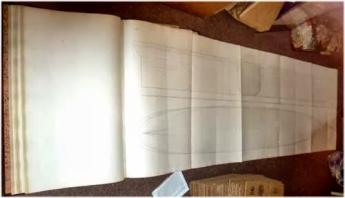Antiquarian Booksellers' Association of America Ten Pound Island Book Company
Collecting Rare Books and First Editions - The Original Big Book

By Greg Gibson
In the “random” (this week’s nomination for a word that’s been misused to death) way typical of buying trips, last week’s journey through Maine, New Brunswick, and Nova Scotia yielded some interesting and unexpected finds.
For example, I had no idea that I would uncover an album of 24 silver prints, circa 1890, of what appear to be damaged European ships (“Casualties”) docked at a Russian shipyard in Odessa, any more than I could have predicted that I’d be offered a handsome 14 x 10 ½” silver print of the start of the 1903 Americas Cup race between Reliance and Shamrock III. Reliance, designed by Nathaniel Herreshoff, and said to be the biggest gaff rigged cutter ever built, won handily in three races. The photo is signed on the mat and stamped on the back by Fulton St. photographer John C. Hemment.
But the biggest purchase, and I mean biggest, was John Scott Russell’s Modern System of Naval Architecture. The book, in three large folio volumes, measures 20 ½ x 27 ½ inches and weighs in at well over 120 pounds. I’ve sold three or four copies over the years. Once I had to mail one. Took me all day to wrap it.
John Scott Russell is an interesting character. He was an engineer and a polymath, but for our purposes his biggest contribution was his discovery of the so-called wave of translation and the resultant wave-line theory of ship construction. Stated most simply, this theory dealt with moving a ship through water in the most efficient manner possible. This, of course had to do with the shape of the ship’s hull, and Scott Russell determined that this shape could be calculated by mathematical means. These are completely beyond my ken, but marine architects of his day grasped the theory easily enough, and Scott Russell’s work was the beginning of modern ship design. It is to him that we owe the design concepts behind the concave bows of the great clipper ships – not to mention The Great Eastern, which he designed.
But Scott Russell’s book has always interested me for another reason. In 1865, the year it was published, Great Britain was at the height of her glory, in the midst of the century-long Pax Britiannica that had been interrupted only by her victory in the Crimean War. I’ve always wondered if the book’s ridiculous size wasn’t a reflection of the inflated esteem with which the British Empire then regarded herself.
Russell, John Scott. THE MODERN SYSTEM OF NAVAL ARCHITECTURE.
Lon. (1865) b/w folding plates. 3 folio vols. xxxviii, 686 pp. plus folding frontis. and 167 plates, many folding double page. Russell was the naval architect responsible for the Great Eastern, and his biographer, George Emmerson, refers to The Modern System... as, “a Great Eastern of books. Doubtless the size of the volumes was dictated by the large scale of the many drawings... It is a monument to Russell’s mastery of his subject, his originality and his capacity as a teacher, a veritable Bible to the naval architects of his time.” Russell (1808-1882), discovered the wave of translation, and developed the wave-line system of ship building. He was an early advocate of iron-clad war- ships, and was fond of the American monitors. He built the Great Eastern (1854-57; launched in 1858), the largest vessel of its day, and the first to have a cellular double-bottom, cellular double upper deck, and longitudinal bulkheads - in short, the first iron ship built to iron design, and not simply an adaptation of wooden shipbuilding. Russell was a founding member of the Institute of Naval Architects in 1860. The Modern System includes detailed plates of monitors, American revolving turrets, yachts, an American river steamboat, merchant, passenger, and naval vessels, a Pacific Mail Steamer, 5 plates of an Australian iron screw passenger steamer, and 22 detailed plates of the Great Eastern. It is possibly the most important work on naval architecture of its time. NYPL List p. 317. See D.N.B. This is a very nice copy of a book often found in tatters because of its unwieldy size. Bound in contemporary or original leather over cloth, showing some scuffing. Plates and text clean and fresh.
Judging by their frequent appearance on the market, the publishers must have sold quite a few copies of The Modern System of Naval Architecture.
I wonder if they had to mail them?
(Posted on Bookman’s Log. Presented here by permission of the author.)

